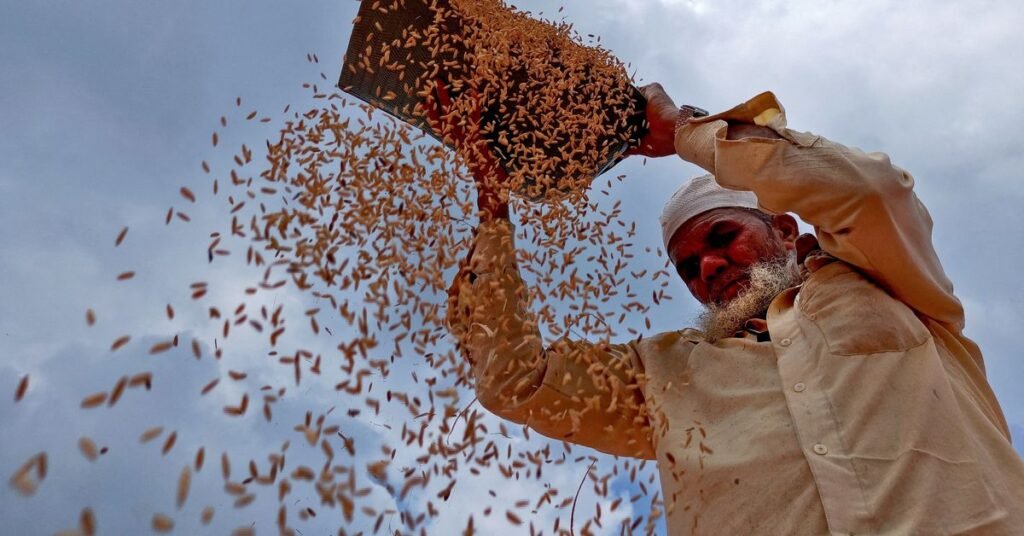SINGAPORE, Dec 13 (Reuters) – Drought or an excessive amount of rain, the warfare in Ukraine and excessive power prices look set to curb international farm manufacturing once more subsequent 12 months, tightening provides, whilst excessive costs encourage farmers to spice up planting.
Manufacturing of staples equivalent to rice and wheat is unlikely to replenish depleted inventories, no less than within the first half of 2023, whereas crops producing edible oils are affected by opposed climate in Latin America and Southeast Asia.
“The world wants report crops to fulfill demand. In 2023, we completely have to do higher than this 12 months,” stated Ole Houe, director of advisory companies at agriculture brokerage IKON Commodities in Sydney.
“As this stage, it seems to be extremely unlikely, if we take a look at the worldwide manufacturing prospects for cereals and oilseeds.”
Wheat, corn and palm oil futures have from dropped from report or multi-year highs however costs within the retail market stay elevated and tight provides are forecast to help costs in 2023.
WHY IT MATTERS
With meals costs climbing to report peaks this 12 months, thousands and thousands of individuals are struggling internationally, particularly poorer nations in Africa and Asia already going through starvation and malnutrition.
Meals imports prices are already heading in the right direction to hit a close to $2 trillion report in 2022, forcing poor international locations to chop consumption.
Benchmark Chicago wheat futures jumped to an all-time excessive of $13.64 a bushel in March after Russia's invasion of key grain exporter Ukraine decreased provides in a market already hit by opposed climate and post-pandemic restrictions.
Corn and soybeans climbed to their highest in a decade, whereas Malaysia's benchmark crude palm oil costs climbed to a report excessive in March.
Wheat costs have since dropped to pre-war ranges and palm oil has misplaced round 40% of its worth, amid fears of a world recession, China's COVID-19 restrictions and an extension of the Black Sea hall deal for Ukrainian grain exports.
WHAT DOES IT MEAN FOR 2023?

[1/3] Ibrahim Shaikh, a farmer, winnows paddy in a discipline at Kadadhe village within the western state of Maharashtra, India, October 17, 2022. REUTERS/Rajendra Jadhav/File Photograph
Whereas flooding in Australia, the world's second largest wheat exporter, in current weeks has induced in depth harm to the crop which was prepared for harvest, a extreme drought is predicted shrink Argentina's wheat crop by nearly 40%.
It will scale back international wheat availability within the first half of 2023.
A scarcity of rainfall within the U.S. Plains, the place the winter crop scores are working on the lowest since 2012, might dent provides for the second half of the 12 months.
For rice, costs are anticipated to stay excessive so long as export duties imposed earlier this 12 months by India, the world's largest provider, stay in place, merchants stated.
“Rice availability in most exporting international locations is fairly skinny besides India, nevertheless it has export duties in place to cut back gross sales,” stated one Singapore-based dealer at a global buying and selling firm.
“If we get a manufacturing shock in any of the highest exporting or importing counties, it may possibly actually swing the market upside.”
The outlook for corn and soybeans in South America seems to be shiny for its harvest in early 2023, though current dryness in elements of Brazil, the world's high bean exporter, has raised worries.
U.S. home provides of key crops together with corn, soybeans and wheat are anticipated to stay cosy into 2023, in line with the U.S. Division of Agriculture.
The company is forecasting U.S. corn provides to fall to a decade low earlier than the 2023 harvest, whereas soybean shares had been seen at a seven-year low and wheat ending shares are forecast on the lowest in 15 years.
Palm oil, the world's most consumed edible oil, is taking a success from tropical storms throughout Southeast Asia the place excessive prices have resulted in decrease use of fertilizer.
Nonetheless, larger costs of grains and cereals have inspired farmers to plant extra crops in some international locations together with India, China and Brazil.
“Planting is larger in a number of international locations however the output is predicted to stay subdued attributable to opposed climate and different elements,” stated Ole. “Manufacturing is unlikely to be sufficient to replenish provides which have been drawn down.”
Discover the Reuters round-up of reports tales that dominated the 12 months, and the outlook for 2023.
Reporting by Naveen Thukral; extra reporting by Mei Mei Chu in Kuala Lumpur and Karl Plume in Chicago; Modifying by Lincoln Feast.
: .

